国防科学技术大学博士学位论文准循环LDPC码的构造及其理论研究姓名:许拔申请学位级别:博士专业:信息与通信工程指导教师:张尔扬2010-04�
国防科学技术大学研究生院博士学位论文 第 i 页 摘 要 QC-LDPC码是一类被广泛应用的结构化LDPC码,由于其奇偶校验矩阵的独特结构,能够利用反馈移位寄存器实现线性复杂度的编码。本文主要针对QC-LDPC码的构造及其理论分析展开研究,主要工作有以下几方面: 1、研究了基于BIBD的QC-LDPC码的构造算法。通过采用有限域上乘法群的思想,将BIBD区组中元素的位置向量与元素在循环群中的幂次直接相对应,避免了大量的求幂与求模运算,极大地简化了位置向量的求解。从理论上证明了新构造的QC-LDPC码对应的Tanner图中围长至少为6。仿真结果表明,构造的QC-LDPC码与随机构造的LDPC码的性能相当,且迭代收敛快,错误平层低;译码性能较传统的BIBD QC-LDPC码有一定的改善。 2、通过对奇偶校验矩阵进行分解,构造出能够抵抗长突发删除错误的好码;根据奇偶校验矩阵本身的结构特点,得出了纠长突发删除错误的能力;同时分析了矩阵分解对码率R的影响,当t越大时,对码率的影响越小,码率本身越大。仿真结果表明,通过矩阵分解构造的码在AWGN和BEC信道中均有良好的性能,距离香农限非常近。 3、研究了IA-LDPC码的最小汉明重量及其码字数目的计算。通过引出支撑矩阵中每行满足Cancel-Out条件的等效条件,给出了码字的判断定理。在此基础上,详细推导了j为2、3与4,5jq==时最小汉明重量及其码字数目;并且给出了5j=和4,7jq=≥时的相应结果,这些结果通过计算机搜索得到。另外,通过分析IA-LDPC的码字特点,刻画了具有最小汉明重量的码字集合0A的组成结构,并推导出0A与1A的关系,其中1A表示支撑矩阵中包含全0列且具有最小汉明重量的码字集合。 4、提出了一种基于Dawson-Sankoff不等式的差错概率下界算法。在重新证明Dawson-Sankoff不等式的基础上,提出了对Dawson-Sankoff下界的改进算法,并对算法合理性进行了严格的数学证明。分别针对AWGN信道与BSC信道,推导了基于传统Dawson-Sankoff界的差错概率下界的表达式,并分析了该下界存在的问题,进而提出了差错冗余事件的判断准则,得到了基于改进Dawson-Sankoff界的差错概率下界算法。仿真结果表明,提出的下界较现有下界性能更紧,与联合上界的距离更近。 关键词:QC-LDPC;BIBD;位置向量;围长;支撑矩阵;最大似然译码;IA-LDPC �
国防科学技术大学研究生院博士学位论文 第 ii 页 Abstract QC-LDPC code, which is a type of the structured LDPC code, is widely applied in several communication systems. QC-LDPC code can be efficiently encoded using simple shift registers with linear complexity, which is mainly owing to the unique structure of the parity-check matrix. This dissertation studies the construction and theoretical analysis of QC-LDPC code, and stresses several tasks below. At first, a novel construction algorithm of QC-LDPC is proposed which is based on the traditional BIBD. Adopting the multiplicative group over finite fields, the algorithm replaces the location vector of the BIBD’s element by the exponent in the multiplicative group, which can avoid a mass of exponential and module calculations and thus simplify the calculation of the location vector. It is strictly proved that the new constructed QC-LDPC codes have girth at least 6 and experimental results show that the performance of these QC-LDPC codes is very close to the random LDPC and converge very fast. Moreover, these QC-LDPC codes have low error-floor and can outperform the traditional BIBD QC-LDPC codes. Secondly, good QC-LDPC codes for correcting erasure-bursts are constructed by the decomposition of the above parity-check matrixes. The ability of correcting erasure-bursts is obtained according to the structure characteristic of the parity-check matrix. In addition, the influence of the code rate caused by decomposition is analyzed, which indicates that the value of t is larger, the influence is smaller and the rate is larger. Simulation results show that codes constructed by decomposition perform well over both AWGN and binary erasure channels and approach the Shannon Limit. Thirdly, the calculation of the minimum Hamming weight and the number of minimum weight codewords of IA-LDPC codes are addressed. The condition, which is equivalent to the cancel-out condition holding for any row of the support matrix, is introduced to prove the judge theorem for the codeword. Based on the above discussion, the minimum Hamming weight and the number of minimum weight codewords of IA-LDPC codes with2,3j= or4,5jq== are deduced in detail, and the same results of IA-LDPC codes with5j= or4,7jq=≥are provided by computer searching. Moreover, the characteristic of the IA-LDPC codeword is analyzed, and the composing structure of the minimum weight codeword set A0 is described, then the relationship between the sizes of the set A0 and A1 is presented, where A1 represents the subset of A0 whose element has the all 0s column in its support matrix. At last, a new lower bound on the error probability is proposed, which is based on Dawson-Sankoff inequality. The bound are obtained by applying a new lower bound on the probability of a union of events, derived by improving on Dawson-Sankoff inequality. The �
国防科学技术大学研究生院博士学位论文 第 iii 页 improved Dawson-Sankoff inequality is strictly proved. For the AWGN and BSC channel, the expressions of the lower bound on the error probability are presented, which are based on the traditional Dawson-Sankoff inequality and the disadvantages of these lower bounds are pointed out and analyzed. Furthermore, the judge rule of the redundant error events is brought forward and the improved lower bound is achieved. Experiment results show that the new lower bound has tighter performance than the existed lower bounds and is very close to union upper bound. Key words:Quasi-Cyclic Low-Density Parity-Check Codes,Balanced Incomplete Block Designs,Location Vector,Girth,Support Matrix,Maximum Likelihood Decoding (ML Decoding),Improper-Array LDPC�
国防科学技术大学研究生院博士学位论文 第 IV 页 表 目 录 表2.1 PEG算法描述......................................................................................................19 表2.2 比特填充算法描述...............................................................................................21 表2.3 2-D EG-LDPC码的构造......................................................................................24 表2.4 2-D PG-LDPC码的构造......................................................................................26 表2.5 BP译码算法.........................................................................................................29 表2.6 BP译码算法的密度进化流程.............................................................................35 表2.7 BP-Based译码算法及其改进算法校验节点消息的概率密度..........................35 表2.8 高斯近似的步骤...................................................................................................37 表3.1 列分解步骤...........................................................................................................47 表3.2 行分解步骤...........................................................................................................48 表3.3 t取不同值时,域GF(12t+1)及其参数对(x,c)...................................................51 表3.4 t取不同值时,域GF(20t+1)及其参数对(x,c)...................................................52 表3.5 GF(5)中元素对应的位置向量比较.....................................................................55 表3.6 三种算法构造的第一类BIBD QC-LDPC码的参数对比.................................56 表3.7 三种算法构造的第二类BIBD QC-LDPC码的参数对比.................................58 表4.1 CIA(q, 4)的最小汉明重量及其码字数目...........................................................114 表4.2 CIA(q, 5)的最小汉明重量及其码字数目...........................................................114 表4.3 CIA(q, 5)与CIA(q, 4)的性能对比........................................................................115 表4.4 仿真码型的具体参数.........................................................................................116 表5.1 例5.2中元素与集合的关系..............................................................................130 表5.2 基于改进Dawson-Sankoff界的误码率下界算法(AWGN).............................134 表5.3 基于改进Dawson-Sankoff界的误码率下界算法(BSC)..................................139 表5.4 针对BCH(63,10)码的性能对比(AWGN).........................................................142 �
国防科学技术大学研究生院博士学位论文 第 V 页 图 目 录 图2.1 (20,3,4)LDPC码的奇偶校验矩阵.......................................................................13 图2.2 (20,3,4)LDPC码的Tanner图..............................................................................14 图2.3 Tanner图中的4圈和6圈...................................................................................14 图2.4 针对存在4圈的Tanner图的比特翻转迭代译码过程......................................15 图2.5 节点集Nlvj的结构示意图....................................................................................18 图2.6 集合S1与S2的关系示意图................................................................................20 图2.7 基于高斯消元的编码...........................................................................................27 图2.8 基于近似下三角矩阵的编码...............................................................................28 图2.9 LDPC码BP译码器结构图.................................................................................38 图2.10 LDPC码BP译码互信息传播图.......................................................................38 图3.1 针对第一类改进的BIBD QC-LDPC码的示意图.............................................59 图3.2 针对第二类改进的BIBD QC-LDPC码的示意图.............................................59 图3.3 第一类改进的BIBD QC-LDPC码的校验矩阵中4圈示意图.........................60 图3.4 第二类改进的BIBD QC-LDPC码的校验矩阵中4圈示意图.........................61 图3.5 基于第一类BIBD QC-LDPC码的译码性能比较(AWGN)..............................67 图3.6 基于第二类BIBD QC-LDPC码的译码性能比较(AWGN)..............................68 图3.7 基于第二类BIBD QC-LDPC码的译码性能比较(BEC)...................................68 图4.1 PA-LDPC码(),PACqj中长度为6的圈................................................................77 图4.2 IA-LDPC码(),IACqj中长度为6的圈.................................................................77 图4.3 A0、A1与各正交子集的关系............................................................................111 图4.4 q取不同值时CIA(q,4)的译码性能....................................................................116 图4.5 q取不同值时CIA(q,5)的译码性能....................................................................117 图4.6 CIA(31,5)、CIA(31,4)与随机构造的LDPC码的性能对比...............................117 图4.7 IA-LDPC码最小汉明重量及其码字数目的计算流程图................................118 图5.1 常见联合概率下界的关系示意图.....................................................................125 图5.2 改进的Dawson-Sankoff界与其它下界的性能对比........................................130 图5.3 引理5.3示意图..................................................................................................136 图5.4 算法流程图.........................................................................................................139 图5.5 针对Regular LDPC (128,3,4)码的下界性能对比(AWGN).............................141 图5.6 针对Golay(23,12)码的下界性能对比(AWGN)...............................................141 图5.7 图5.6在(3.5 , 6)(单位:dB)范围内的放大图..................................................142 �
国防科学技术大学研究生院博士学位论文 第 VI 页 图5.8 针对Regular-LDPC (64,2,4)码的性能对比(BSC)............................................143 图5.9 与A.Cohen Lower bound的性能对比(BSC)....................................................144 图5.10 针对不同码长n的Regular-LDPC(n,3,4)码的性能对比(BSC).....................144 图5.11 针对不同行重k与码长n的Regular-LDPC码的性能与时间对比(BSC)..145 图C.1 码字与接收矢量的位置关系示意图................................................................165 �
独 创 性 声 明 本人声明所呈交的学位论文是我本人在导师指导下进行的研究工作及取得的研究成果。尽我所知,除了文中特别加以标注和致谢的地方外,论文中不包含其他人已经发表和撰写过的研究成果,也不包含为获得国防科学技术大学或其它教育机构的学位或证书而使用过的材料。与我一同工作的同志对本研究所做的任何贡献均已在论文中作了明确的说明并表示谢意。 学位论文题目: 准循环LDPC码的构造及其理论研究 学位论文作者签名: 日期: 年 月 日 学位论文版权使用授权书 本人完全了解国防科学技术大学有关保留、使用学位论文的规定。本人授权国防科学技术大学可以保留并向国家有关部门或机构送交论文的复印件和电子文档,允许论文被查阅和借阅;可以将学位论文的全部或部分内容编入有关数据库进行检索,可以采用影印、缩印或扫描等复制手段保存、汇编学位论文。 (保密学位论文在解密后适用本授权书。) 学位论文题目: 准循环LDPC码的构造及其理论研究 学位论文作者签名: 日期: 年 月 日 作者指导教师签名: 日期: 年 月 日 �

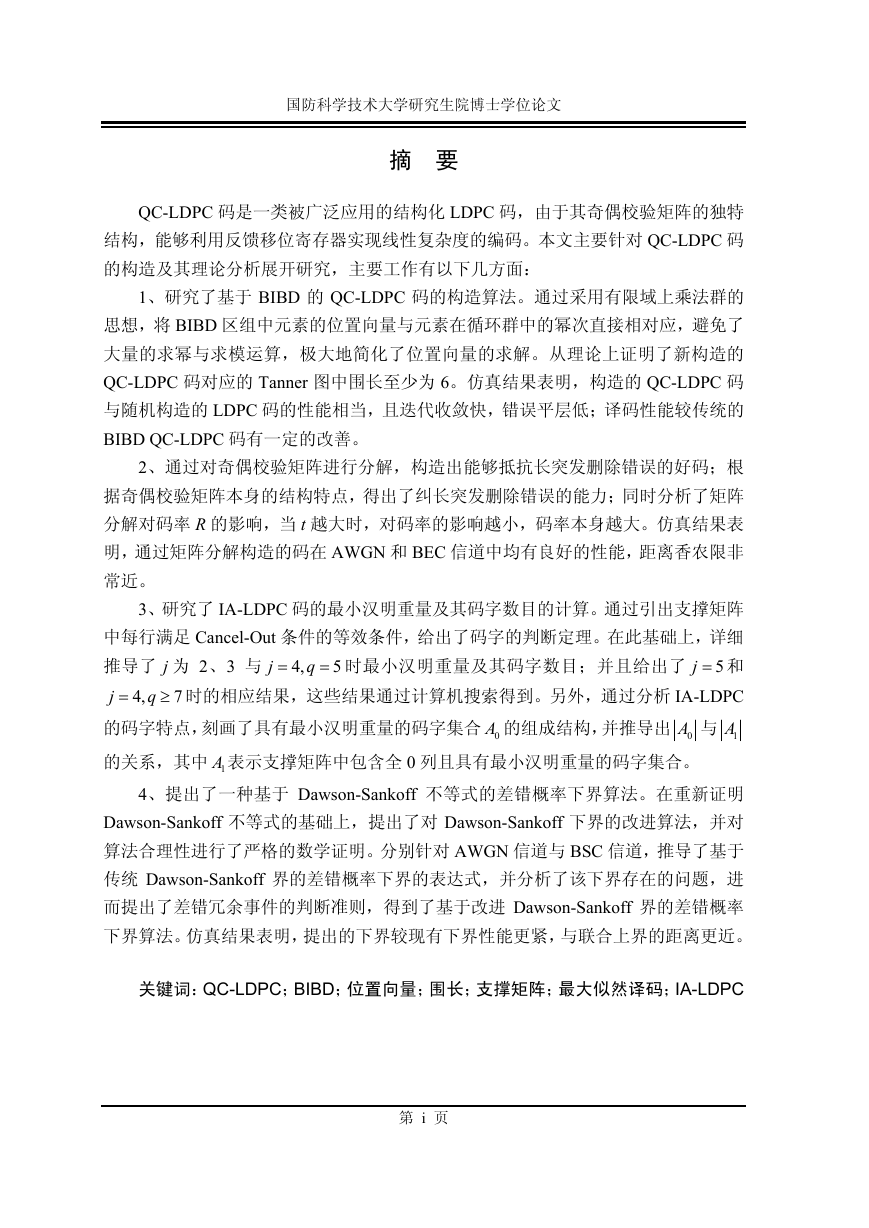
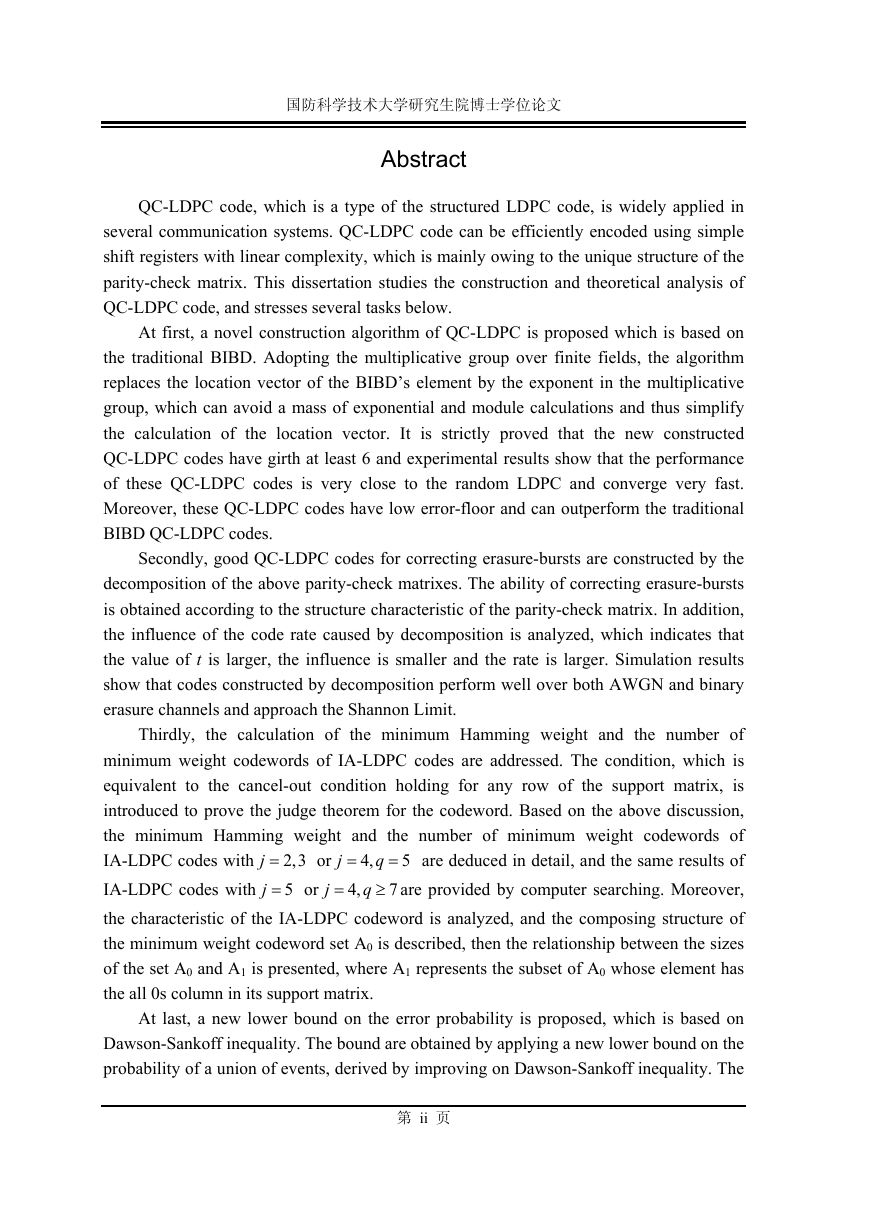
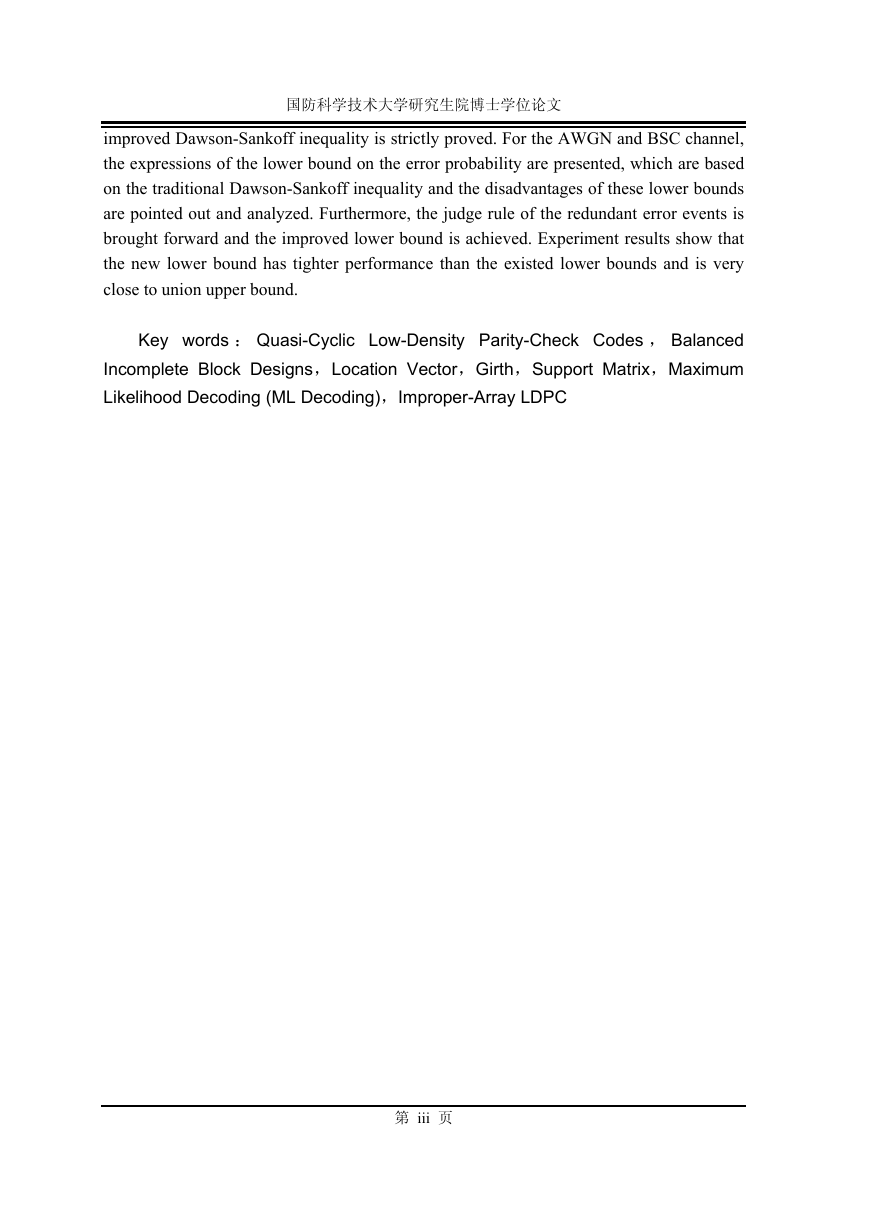
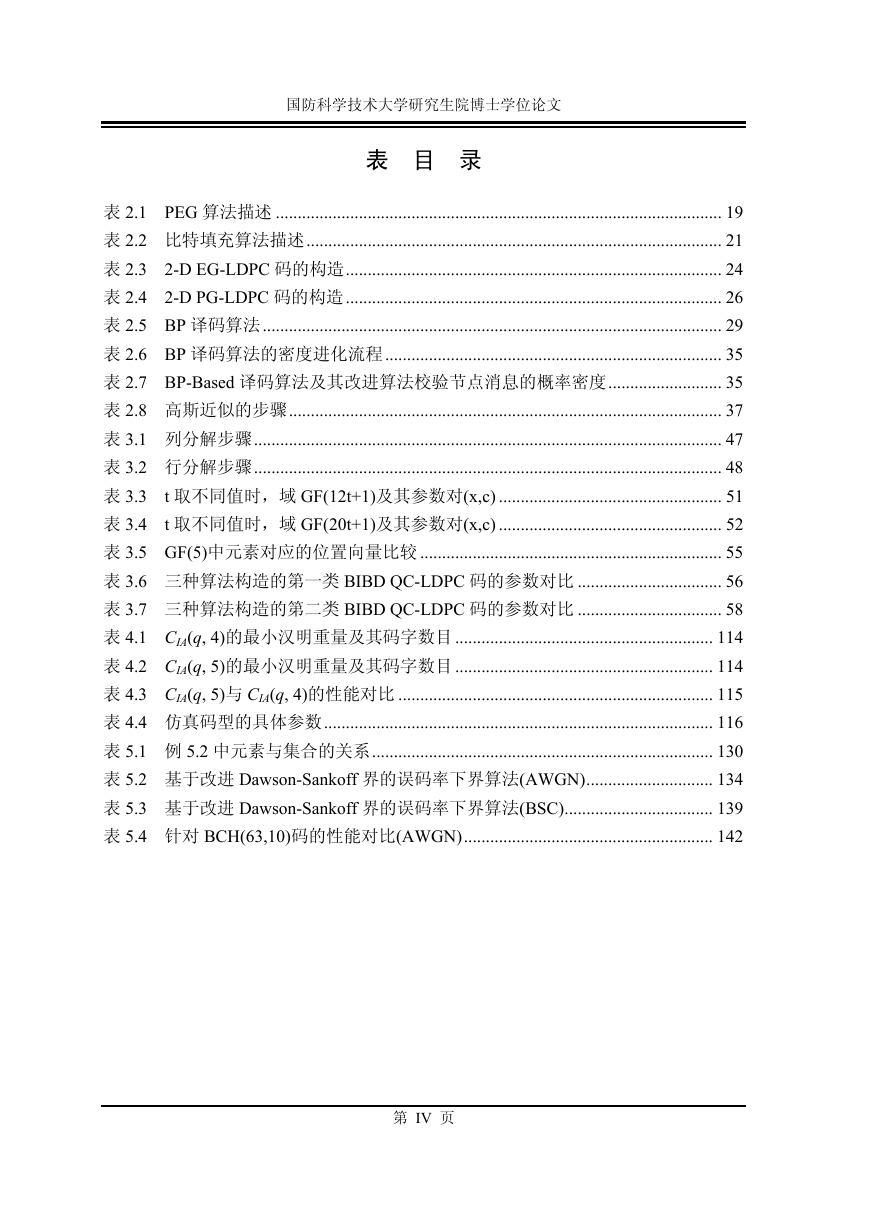
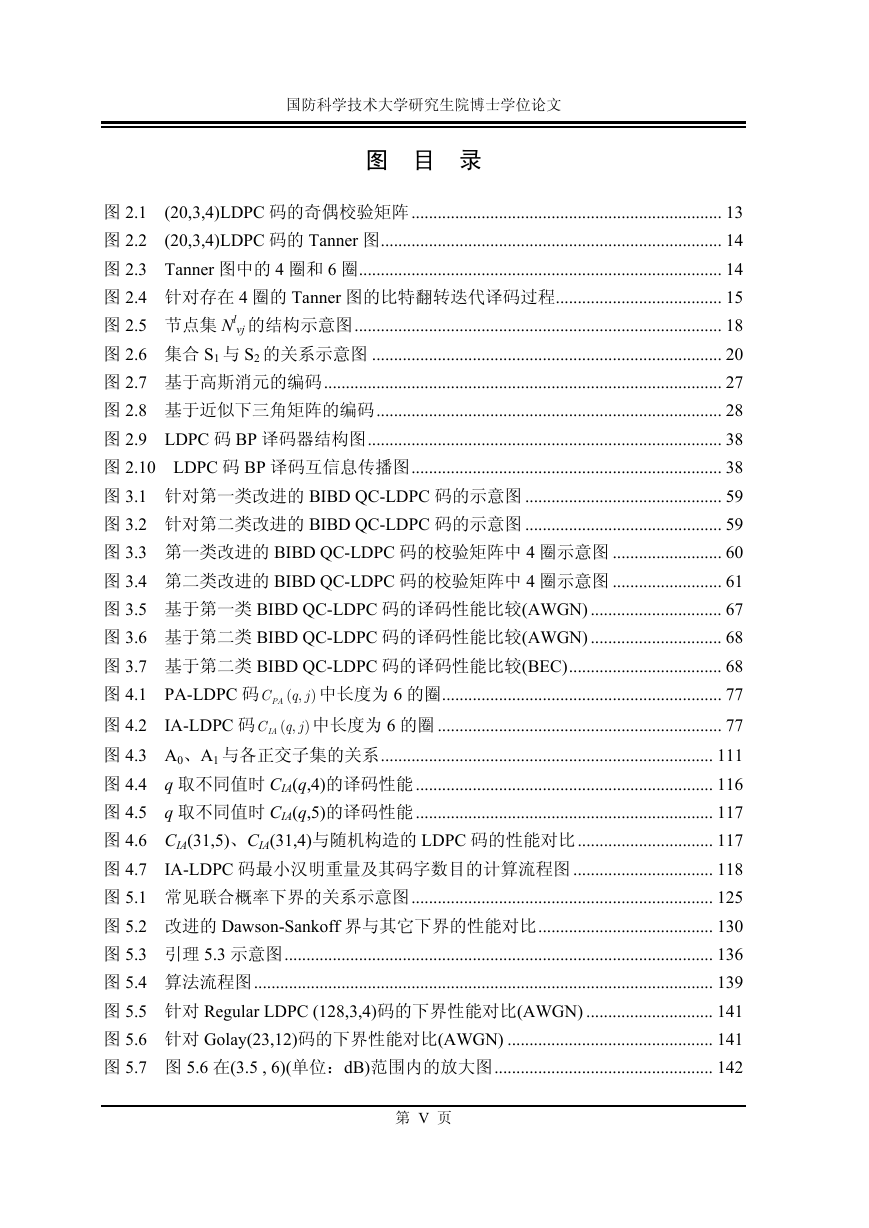
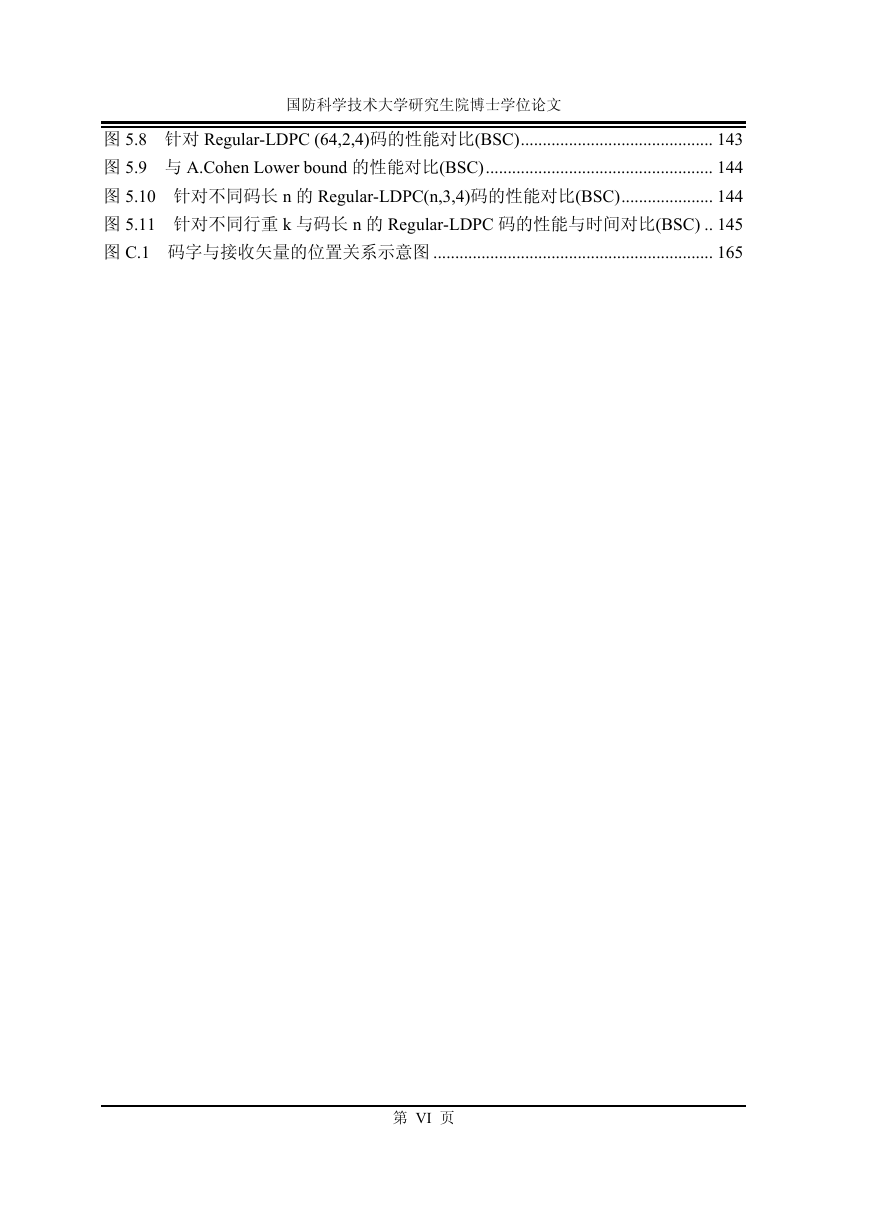
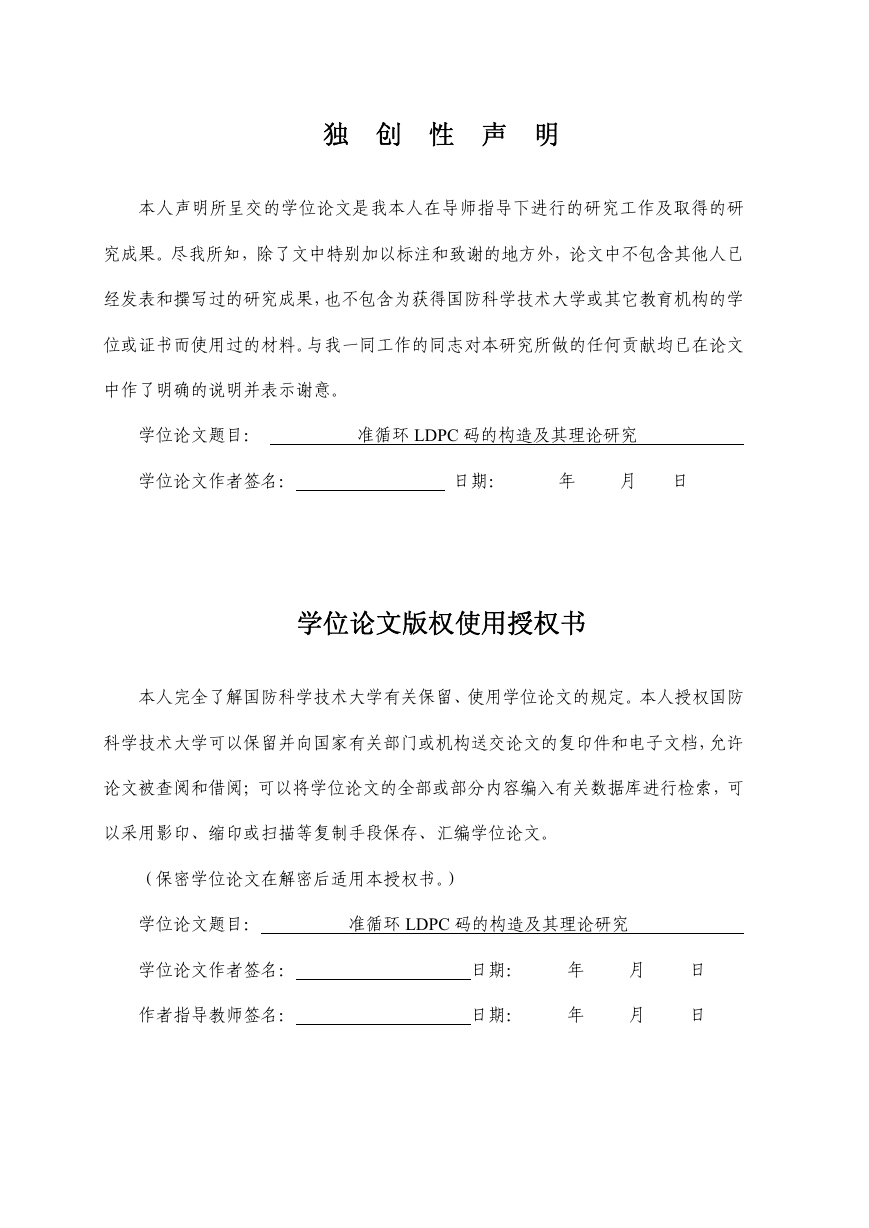








 2023年江西萍乡中考道德与法治真题及答案.doc
2023年江西萍乡中考道德与法治真题及答案.doc 2012年重庆南川中考生物真题及答案.doc
2012年重庆南川中考生物真题及答案.doc 2013年江西师范大学地理学综合及文艺理论基础考研真题.doc
2013年江西师范大学地理学综合及文艺理论基础考研真题.doc 2020年四川甘孜小升初语文真题及答案I卷.doc
2020年四川甘孜小升初语文真题及答案I卷.doc 2020年注册岩土工程师专业基础考试真题及答案.doc
2020年注册岩土工程师专业基础考试真题及答案.doc 2023-2024学年福建省厦门市九年级上学期数学月考试题及答案.doc
2023-2024学年福建省厦门市九年级上学期数学月考试题及答案.doc 2021-2022学年辽宁省沈阳市大东区九年级上学期语文期末试题及答案.doc
2021-2022学年辽宁省沈阳市大东区九年级上学期语文期末试题及答案.doc 2022-2023学年北京东城区初三第一学期物理期末试卷及答案.doc
2022-2023学年北京东城区初三第一学期物理期末试卷及答案.doc 2018上半年江西教师资格初中地理学科知识与教学能力真题及答案.doc
2018上半年江西教师资格初中地理学科知识与教学能力真题及答案.doc 2012年河北国家公务员申论考试真题及答案-省级.doc
2012年河北国家公务员申论考试真题及答案-省级.doc 2020-2021学年江苏省扬州市江都区邵樊片九年级上学期数学第一次质量检测试题及答案.doc
2020-2021学年江苏省扬州市江都区邵樊片九年级上学期数学第一次质量检测试题及答案.doc 2022下半年黑龙江教师资格证中学综合素质真题及答案.doc
2022下半年黑龙江教师资格证中学综合素质真题及答案.doc